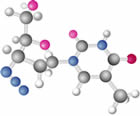Types of stainless steel
There are different types of stainless steels: when nickel, for instance is added the austenite structure of iron is stabilized.What is stainless steel?
This crystal structure makes such steels non-magnetic and less brittle at low temperatures. For higher hardness and strength, carbon is added. When subjected to adequate heat treatment these steels are used as razor blades, cutlery, tools etc.Significant quantities of manganese have been used in many stainless steel compositions. Manganese preserves an austenitic structure in the steel as does nickel, but at a lower cost.
Stainless steels are also classified by their crystalline structure:
- Austenitic stainless steels comprise over 70% of total stainless steel production. They contain a maximum of 0.15% carbon, a minimum of 16% chromium and sufficient nickel and/or manganese to retain an austenitic structure at all temperatures from the cryogenic region to the melting point of the alloy. A typical composition is 18% chromium and 10% nickel, commonly known as 18/10 stainless is often used in flatware. Similarly 18/0 and 18/8 is also available. ¨Superaustenitic〃 stainless steels, such as alloy AL-6XN and 254SMO, exhibit great resistance to chloride pitting and crevice corrosion due to high Molybdenum contents (>6%) and nitrogen additions and the higher nickel content ensures better resistance to stress-corrosion cracking over the 300 series. The higher alloy content of "Superaustenitic" steels means they are fearsomely expensive and similar performance can usually be achieved using duplex steels at much lower cost.
- Ferritic stainless steels are highly corrosion resistant, but far lessdurable than austenitic grades and cannot be hardened by heat treatment. They contain between 10.5% and 27% chromium and very little nickel, if any. Most compositions include molybdenum; some, aluminium or titanium. Common ferritic grades include 18Cr-2Mo, 26Cr-1Mo, 29Cr-4Mo, and 29Cr-4Mo-2Ni.
- Martensitic stainless steels are not as corrosion resistant as the other two classes, but are extremely strong and tough as well as highly machineable, and can be hardened by heat treatment. Martensitic stainless steel contains chromium (12-14%), molybdenum (0.2-1%), no nickel, and about 0.1-1% carbon (giving it more hardness but making the material a bit more brittle). It is quenched and magnetic. It is also known as "series-00" steel.
- Duplex stainless steels have a mixed microstructure of austenite and ferrite, the aim being to produce a 50:50 mix although in commercial alloys the mix may be 60:40. Duplex steel have improved strength over austenitic stainless steels and also improved resistance to localised corrosion particularly pitting, crevice corrosion and stress corrosion cracking. They are characterised by high chromium and lower nickel contents than austenitic stainless steels.
The AISI defines the following grades among others:
- 200 Series austenitic iron-chromium-nickel-manganese alloys
- 300 Series austenitic iron-chromium-nickel alloys
-
- Type 301 highly ductile, for formed products. Also hardens rapidly during mechanical working.
- Type 303 Free machining version of 304 via addition of sulfur
- Type 304 the most common; the classic 18/8 stainless steel.
- Type 316 the next most common; for food and surgical stainless steel uses; Alloy addition of molybdenum prevents specific forms of corrosion. Also known as "marine grade" stainless steel due to its increased ability to resist saltwater corrosion compared to type 304. SS316 is often used for building nuclear reprocessing plants.
- 400 Series ferritic and martensitic alloys
-
- Type 408 heat-resistant; poor corrosion resistance; 11% chromium, 8% nickel.
- Type 409 cheapest type; used for automobile exhausts; ferritic (iron/chromium only).
- Type 410 martensitic (high-strength iron/chromium).
- Type 420 "Cutlery Grade" martensitic; similar to the Brearley's original "rustless steel". Also known as "surgical steel".
- Type 430 decorative, e.g. for automotive trim; ferritic.
- Type 440 a higher grade of cutlery steel, with more carbon in it, which allows for much better edge retention when the steel is heat treated properly.
- 600 Series martensitic precipitation hardening alloys
-
- Type 630 most common PH stainless, better known as 17-4; 17% chromium, 4% nickel
Related products |
|
<
>
|





